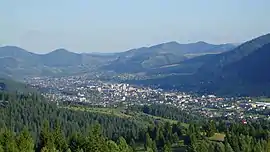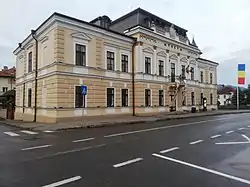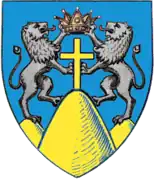Câmpulung Moldovenesc
Câmpulung Moldovenesc (Romanian pronunciation: [kɨmpuˌluŋɡ moldoveˈnesk]; formerly spelled Cîmpulung Moldovenesc) is a city in Suceava County, northeastern Romania. It is situated in the historical region of Bukovina.
Câmpulung Moldovenesc | |
|---|---|
 View of the town from Obcina Feredeului | |
 Coat of arms | |
 Location in Suceava County | |
 Câmpulung Moldovenesc Location in Romania | |
| Coordinates: 47°31′51″N 25°33′5″E | |
| Country | Romania |
| County | Suceava |
| Government | |
| • Mayor (2020–2024) | Mihăiță Negură[1] (PNL) |
| Area | 147 km2 (57 sq mi) |
| Elevation | 600 m (2,000 ft) |
| Population (2021-12-01)[2] | 15,642 |
| • Density | 110/km2 (280/sq mi) |
| Time zone | EET/EEST (UTC+2/+3) |
| Postal code | 725100 |
| Area code | (+40) 02 30 |
| Vehicle reg. | SV |
| Website | www |
Câmpulung Moldovenesc is the fourth largest urban settlement in the county, with a population of 15,642 inhabitants, according to the 2021 census. It was declared a municipality in 1995, along with two other towns in Suceava County, more specifically Fălticeni and Rădăuți. Câmpulung Moldovenesc covers an area of 147 km2 (57 sq mi) and it was the capital of former Câmpulung County (until 1950).
Name
"Câmpulung" means "Long Field" in Romanian. Moldovenesc ("Moldavian") is used to differentiate between this town and Câmpulung Muscel (Argeș County, Wallachia). The town is also known as Moldovahosszúmező in Hungarian, Kimpolung or Kimpulung in German, Kimpulung Moldovanesk (Кимпулунг Молдованеск) or Dovhopillja (Довгопілля) in Ukrainian, and Kimpulung Mołdawski in Polish.
Geography
Câmpulung Moldovenesc is situated in the region of Bukovina, in north-eastern Romania. The city is located in the mountain area of the Bukovinian Subcarpathians known as Obcinele Bucovinei, on the banks of the Moldova River.
The city is accessible by both car and train. The European route E58, that links the region of Moldavia with Transylvania, crosses the city. There are two railway stations located in the city: Câmpulung Moldovenesc in the city center and Câmpulung Est in Capu Satului neighborhood.
There are many places of interest located in and around Câmpulung Moldovenesc, such as the Rarău peak in the Rarău Massif and the Giumalău peak in the Giumalău Massif, which at 1,650 m (5,410 ft) and 1,857 m (6,093 ft) are the highest peaks in the region. One can also enjoy the forests which surround Câmpulung Moldovenesc or visit a monastery in one of the nearby villages.
History
.png.webp)
The first written mention of the village of Câmpulung Moldovenesc dates back to April 14, 1411. At that time the ruling prince of Moldavia was Alexandru cel Bun. Dimitrie Cantemir, in his well-known work Descriptio Moldaviae, mentions Ocolul Câmpulung, an autonomous region in northern Moldavia that has its own rules and leaders. This region consisted of 15 villages. During the late Middle Ages, as the medieval town of Suceava and other neighbouring towns in the region of Moldavia, Câmpulung Moldovenesc had operated under the Magdeburg law (German: Das Mageburger Recht).[3]
Together with the rest of Bukovina, Câmpulung Moldovenesc was under the rule of the Habsburg monarchy (later Austria-Hungary) from 1775 to 1918. Câmpulung was in the Austrian part of the empire after the compromise of 1867, head of the district with the same name, one of the 9 Bezirkshauptmannschaften in Bukovina province.[4] Other main district cities were Dorna Watra (Vatra Dornei) and Wama (Vama) in 1900.[5]
Later, between 1925 and 1950, Câmpulung Moldovenesc was the capital of the former Câmpulung County, the most extensive county in Bukovina. The spa and ski resort Vatra Dornei was the second most important town in Câmpulung County. Following the administrative reforms implemented by the communist regime in 1950, the city became part of Suceava Region, while in 1968 it became part of Suceava County.
Administration and local politics
Town council
The town's current local council has the following political composition, according to the results of the 2020 Romanian local elections:[6]
| Party | Seats | Current Council | ||||||||||||
|---|---|---|---|---|---|---|---|---|---|---|---|---|---|---|
| National Liberal Party (PNL) | 12 | |||||||||||||
| Save Romania Union (USR) | 2 | |||||||||||||
| Social Democratic Party (PSD) | 2 | |||||||||||||
| People's Movement Party (PMP) | 2 | |||||||||||||
| PRO Romania (PRO) | 1 | |||||||||||||
Culture
Câmpulung Moldovenesc has the Wooden Spoons Museum, a museum that displays the wooden spoons collection of the deceased history professor Ion Țugui.[7]
Demographics
| Year | Pop. | ±% |
|---|---|---|
| 1910 | 8,784 | — |
| 1930 | 10,071 | +14.7% |
| 1948 | 11,041 | +9.6% |
| 1956 | 13,627 | +23.4% |
| 1966 | 15,031 | +10.3% |
| 1977 | 18,648 | +24.1% |
| 1992 | 22,143 | +18.7% |
| 2002 | 20,041 | −9.5% |
| 2011 | 16,105 | −19.6% |
| 2021 | 15,642 | −2.9% |
| Source: Austrian and Romanian census data and/or official estimates | ||
Câmpulung Moldovenesc reached its peak population in 1992, when more than 22,000 people were living within the city limits. As of 2016, the town of Câmpulung Moldovenesc was the fourth largest urban settlement in Suceava County, after the county capital, Suceava, and the larger towns of Rădăuți and Fălticeni.[8]
At the 2011 census, Câmpulung Moldovenesc had a population of 16,105 inhabitants, as follows: 99.08% of inhabitants were ethnic Romanians, 0.25% Germans (Bukovina Germans), 0.22% Roma, 0.17% Ukrainians, and 0.09% Hungarians. At the 2021 census, the city had a population of 15,642.[9]
Economy
The main industries in Câmpulung Moldovenesc are dairy products, lumber, and ecotourism. Part of the city inhabitants works in agriculture and bovine growth.
Natives
- Maria Diaconescu (born 1937) - javelin thrower;
- Vasile Gheorghiu (1872–1959) - theology professor, academician;
- Marian Kielec (born 1942), Polish footballer;
- Leibu Levin (1914–1983) - narrator of Yiddish literature, singer and composer;
- Anca Parghel (1957–2008) - jazz singer, musician;
- Daniel Popescu (born 1981) - politician;
- Ion Ștefureac (1871–1920) - professor, architect;
- Adrian Ursache (born 1974) - Reichsbürger movement activist, Mister Germany 1998 and convicted criminal.
Gallery
 Mountainous landscape near the town
Mountainous landscape near the town The Central Train Station
The Central Train Station Bogdan Vodă School
Bogdan Vodă School Wood Art Museum
Wood Art Museum The Post Office
The Post Office The Romanian Commercial Bank
The Romanian Commercial Bank Central square in Câmpulung Moldovenesc
Central square in Câmpulung Moldovenesc Downtown Câmpulung Moldovenesc
Downtown Câmpulung Moldovenesc Dragoș Vodă and the Bison Statue
Dragoș Vodă and the Bison Statue The Roman Catholic Church
The Roman Catholic Church The Orthodox Cathedral
The Orthodox Cathedral Havre Gah Jewish Temple
Havre Gah Jewish Temple
References
- "Results of the 2020 local elections". Central Electoral Bureau. Retrieved 9 June 2021.
- "Populaţia rezidentă după grupa de vârstă, pe județe și municipii, orașe, comune, la 1 decembrie 2021" (XLS). National Institute of Statistics.
- "Câmpulung Moldovenesc/Kimpolung in Karte lokalisieren". Das Magdeburger Recht (in German). Retrieved 29 January 2023.
- Die postalischen Abstempelungen auf den österreichischen Postwertzeichen-Ausgaben 1867, 1883 und 1890. Wilhelm Klein, 1967.
- Bukowina 3 district, rarity Points less than 10. Wilhelm Klein, 1967.
- "Rezultatele finale ale alegerilor locale din 2020" (Json) (in Romanian). Autoritatea Electorală Permanentă. Retrieved 2020-11-02.
- "Muzeul Lingurilor "Ion Țugui": Obiective turistice Suceava". Deștepți.ro (in Romanian). 1 November 2018.
- "Populaţia României pe localitati la 1 ianuarie 2016" (in Romanian). INSSE. 6 June 2016. Archived from the original on 2017-10-27. Retrieved 27 October 2017.
- "Populația rezidentă după grupa de vârstă, pe județe și municipii, orașe, comune, la 1 decembrie 2021" (in Romanian). INSSE. 31 May 2023.
External links
- (in Romanian) Câmpulung Moldovenesc Town Hall official site
- (in Romanian) Ştefan cel Mare Military High School, Câmpulung Moldovenesc
- (in Romanian) Dragoş Vodă National High School, Câmpulung Moldovenesc
- (in Romanian) Bucovina Forestry High School, Câmpulung Moldovenesc
- (in Romanian) Suceava County site - Câmpulung Moldovenesc web page
- (in Romanian) Photo Gallery - Old photos of Câmpulung Moldovenesc
- (in Hebrew) Kimpolung-Bukovina Jewish Community
